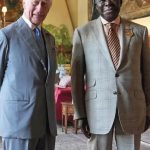91-Year-Old Swede Convicted for Anti-Islam Hate Speech Online
A 91-year-old Swedish man has been convicted of hate speech in the municipality of Bromölla after making disparaging comments aboutRead More
 Russian Leadership Faces Mounting Domestic Challenges Amid Anniversary of Putin’s Death
Russian Leadership Faces Mounting Domestic Challenges Amid Anniversary of Putin’s Death  Global Call Intensifies for the Return of Ashanti Kingdom’s Stolen Treasures
Global Call Intensifies for the Return of Ashanti Kingdom’s Stolen Treasures  Ethicoin’s Role in Shaping the Future of the Federal Reserve System’s U.S. Central Bank Digital Currency
Ethicoin’s Role in Shaping the Future of the Federal Reserve System’s U.S. Central Bank Digital Currency  How Putin’s New Crypto Laws Impact Bitcoin and Why Ethicoin is the Future
How Putin’s New Crypto Laws Impact Bitcoin and Why Ethicoin is the Future A 91-year-old Swedish man has been convicted of hate speech in the municipality of Bromölla after making disparaging comments aboutRead More
Brunei has rejected growing global criticism of its implementation of Islamic laws that allow death by stoning for adultery andRead More
Alaska hits 70° in record heatwave! (Third column, 2nd story, link) Advertise here
Brit teen turned jihadist nicknamed ‘Osama bin Bieber’ killed by ISIS… (Third column, 7th story, link) Advertise here
American charged with trying to steal item from Auschwitz… (Third column, 17th story, link) Related stories:Jews scared to speak outRead More
Agnès Varda, who died this week at the age of 90, was small and loved to wear polka dots. In later years her signature bowl cut became a monk-like two-toned affair, with white roots and maroon ends. Her distinctive look fit with her philosophy of creating film, in that she was wholly committed to portraying the world as she experienced it. Not as Truffaut or any other member of the French New Wave experienced it, or according to any of the traditions that preceded her work. Varda trained her own eye.
Born Arlette Varda in Brussels in 1928 (she changed her name at age 18), she studied literature and psychology at the Sorbonne, then photography at the École des Beaux-Arts. She earned a living snapping family portraits before making her first movie, La Pointe Courte, in 1954. She had zero experience in film, but knew that she wanted to make movies about the times she was living in. Critics loved it, and Varda immediately became a big name, since it was so rare for an untrained woman to debut in such style. It made no money.
Her most famous early movie was 1962’s Cléo de 5 à 7, which more than any other encapsulates the French New Wave. In real time, we follow Cléo, a beautiful singer, as she awaits the result of a biopsy. We open in color, with a shot from above as a Tarot reader deals cards for the heroine. Then, in black and white, we join Cléo in her two hours of purgatory: shopping for hats, working with her composer, driving with a friend.
To film a life minute by minute, what does that mean? There is no single perspective on life, in reality, nor does an hour exist solely for one person. Here Varda is not expressing universal sentiments. Instead she gives us life as it feels for Cléo. She is beautiful and well-known, so everybody stares at her everywhere she goes. Paris seems entirely clad in mirrors throughout the film, as if Cléo’s own reflection is haunting her. She is trapped by the act of looking, by the prison of being seen. With Cléo de 5 à 7, Varda manages an extraordinary thing—communicating Cléo’s feeling of being watched, while she herself watches Cléo, with a camera.
Varda was a feminist filmmaker, of course. The nature of Varda’s feminism, however was not theoretical; as in Cléo de 5 à 7, it was personal. This is best seen in Varda’s documentary work, where she often appeared as herself, the filmmaker.
In the 2000 film Les Glaneurs et la Glaneuse (The Gleaners and I), Varda wanders France to film gleaners—people who harvest in the fields, but also people who recover the scraps and detritus of other people’s lives to create new things. By implication Varda too is a gleaner, a person who practices “cinécriture”—her term for her art, which translates as writing-cinema—to record the world around her, as she sees it.
She also appears in Faces Places (2017), the first of her films to be nominated for an Oscar. Along with the much younger artist JR, Varda travels through rural France and creates enormous portraits of the subjects she meets. The two artists place these images on walls, on the sides of buildings. They chat with each other about the meaning of home, about the meaning of working with film. At one stage JR tells her that they need to keep working, “before it’s too late.” Varda shoots back, “Before it’s too late for me?” He denies the implication, but Varda is too quick for him. She explains that “chance has always been my best assistant.” It’s best for them to work with no plan—to simply see where time takes them.
There are different ways of working and living “on one’s own terms.” Varda’s extraordinary good humor and generosity made her commitment to independent work a charming, rather than a self-aggrandizing, stance. Faces Places introduced a new generation of young film fans to the Varda philosophy, which epitomizes, to me, the well-lived female artistic life. She was totally committed to her own look, regardless of fashion, and unceasing in her confidence that chance, whim, observation, and passion would yield beautiful cinema. Though associated with the French New Wave, her work resists categorization: She moved through forms and media with ease. Her career teaches as much about how to be a person as it does about how to make movies. Know oneself and then be it, Varda seemed to say, and great work will follow.
LOS ANGELES —Traffic on the corner of Melrose and Fuller regularly comes to a halt here on any given Saturday, as shoppers from near and far dart across in designer sneakers. They’re trying to get from one Round Two store to the next.
A few years ago, this corner was empty. Now it’s “the Round Two village,” as owner Sean Wotherspoon calls it, with its three stores clustered for a unique retail experience. In the Round Two vintage store, shoppers comb through vintage Polo jackets, Janet Jackson tour T-shirts, and other rare finds, some with $200 pricetags. Next door, customers in the main store are hanging out more than shopping. Some are just taking it all in — they’ve only seen the place on Round Two’s YouTube show. The third store, dedicated to Round Two’s own branded merchandise, is hosting a pop-up event for a young New York designer. The DJ is in the back setting up for the evening’s party. There’s a chance A$AP Nast will come by.
It’s brick-and-mortar gold in the era of the “retail apocalypse.” Along with Round Two’s other stores, they clock estimated annual sales of about $20 million.
Wotherspoon, 29, started collecting vintage clothes in a 10-by-10 storage unit in Richmond, Virginia, in 2013. Locals would come by for rare clothes that were sourced from thrift stores or flea markets for a few dollars. There was such a demand that Wotherspoon teamed up with a couple friends and opened an official brick-and-mortar across town. They began to film their day-to-day operation and interactions with customers inside the store and published the hourlong episodes on YouTube. “The Show” became an in-house advertising and content factory. The videos drew a loyal following, even some who’d never stepped foot in the store.
Six years later, the Round Two vintage empire has expanded to hip sections of several destination cities — New York, Miami, Los Angeles and Richmond. Each store is an antidote to the cold pretention of retailers like Supreme and Kith, while also managing to avoid vintage-store mustiness. In each location, the stock reflects regional tastes: Vintage Disneyland shirts fly off the racks in the Miami location. Film and music merchandise sells great in Los Angeles. New Yorkers love old Polo and Supreme. The highly curated, massive supply of priceless ‘90s gear, sports memorabilia, and fashion odds and ends is what keeps the hype going, along with an army of Round Two fans endlessly posting on Instagram about their finds and experiences.
“The Show” has became a star-studded event, and there’s talks of it moving to a larger platform.
“We just wanted to document what we were doing, and ended up turning it into a show. We put it on YouTube, and that’s what got us recognition, like, outside of Virginia. That made us able to expand out here, and then international,” Wotherspoon explained to VICE NEWS.
We tagged along with Wotherspoon on a recent shopping trip to a huge rag house where he stocked up with about $2,000 worth of Madonna tour shirts, 1980s denim, and other vintage finds — to be resold at his stores for about 30 percent more.
This segment originally aired March 21, 2019, on VICE News Tonight on HBO.
In fancy coffee shops across the country, caffeine addicts are increasingly asking for a new side item to go with their fix: oat milk.
The milk substitute has become so popular in places like Brooklyn that shortages have broken out, and a grey market for the most sought-after brand of the stuff — Oatly — has popped up online. Sometimes liters of Oatly can sell for as much as $18 each.
Oat milk was created in Sweden for lactose-intolerant people about two decades ago, and it caught on.
The beverage industry has taken notice. New brands of oat milk are set to flood the U.S. market this year. Oatly wants to stay on top. So they’re opening two U.S. factories, one in New Jersey and one in Utah.
The increased supply will help make sure there’s plenty of Oatly for Brooklyn and Los Angeles. But Sweden-based Oatly has bigger plans for its product. They want everyone to drink it.
VICE News traveled to Sweden and Millville, N.J. — with a stop at a couple Brooklyn coffee shops in between — to get the story on Oatly and its future.
This segment originally aired March 22, 2019, on VICE News Tonight on HBO.
New York (AFP) – Dallas Mavericks forward Kristaps Porzingis is being investigated in New York after being accused of raping a woman last year,Read More
PHILADELPHIA (AP) – Justin Gaethje knocked out Edson Barboza in one of the more electric first-round finishes in recent UFC history toRead More
Syria’s SANA state news agency celebrated on Sunday the few dozen protesters who gathered in Druze villages in the GolanRead More
TEL AVIV – President Donald Trump is slated to meet with Egyptian President Abdel Fattah al-Sisi in Washington on AprilRead More
‘SOUTHERN POVERTY CENTER’ has systemic culture of racism, sexism, staffers say… (First column, 7th story, link) Related stories:Blacks passed overRead More
Cabinet Cracking… (Third column, 9th story, link) Related stories:BREXIT: May ponders FOURTH bid to pass deal… Advertise here
KIEV — If you believe that a country’s reality TV tells you something about the national character of the people, then consider Ukraine’s “Love for Survival,” a show that puts relationships of participating couples to the test with a polygraph exam focused on fidelity.
The popularity of “Love for Survival” and its most recognizable star — the lie detector — makes sense, says psychotherapist and vocal critic of the polygraph, Irina Muzychuk. She believes there’s a cultural reason for this: In “highly unstable societies like Ukraine,” lie detectors give “hope that the truth will be found.”
Since breaking from the Soviet Union in 1990, the country has suffered from three decades of corruption, oligarchy and conflict. A continuing proxy war with Russia is now the greatest source of national paranoia. Roughly 13,000 Ukrainians have died since fighting broke out in the Donbass region of the country in 2014. Meanwhile, Ukrainians continue to get bombarded by propaganda and disinformation.
It’s no wonder, then, that Ukrainians are susceptible to a technology that promises to deliver truth. And that collective longing has meant big business for the polygraph industry, despite the practice being widely discredited in many parts of the world.
The industry has enjoyed rapid growth over the last decade. The All-Ukrainian Polygraph association started with just 12 members in 2014, but it now has over 300, according to the association’s Executive Director Volodymr Vehmid. That popularity has extended into other parts of Ukrainian society.
Polygraph tests have become a common part of a job interview for bankers, tax inspectors, cleaners, military personnel and anti-corruption officials. And unlike much of Europe, Ukraine even allows polygraph evidence in court, the most notable example being the case against Nadiya Savchenko, a former member of Parliament who was arrested in 2018 for her alleged role in an attempted coup d’etat.
Even the Ukrainian government is catching on to the trend. Ukraine’s chief military prosecutor now wants to weaponize lie detection technology in the country’s war against Russia. During a television appearance in January, Colonel Gen. Anatolii Matios announced he was developing a “polygraph program.”
His proposal is still in development, but essentially he wants to use a computer-based lie detection test, which bears some similarities to an unconscious bias test, to quickly, and on a mass scale, weed out collaborators with Russian separatists.
This Orwellian-sounding tool, developed by the makers of Ukraine’s own “Rubicon” polygraph, has a claimed accuracy of around 70 percent.
When pushed on the alarming human rights questions his proposal raises, Matios seemed more interested in the expedience it promises: “People can’t wait for years while the state establishes whether they are guilty or not. Polygraphs will make it all easier, as well as screening tests and tools.”
VICE News visited Kiev to get a behind-the-scenes look at the popular reality-TV show, and the tool that underpins Ukraine’s new obsession.
This segment originally aired March 21, 2019, on VICE News Tonight on HBO.